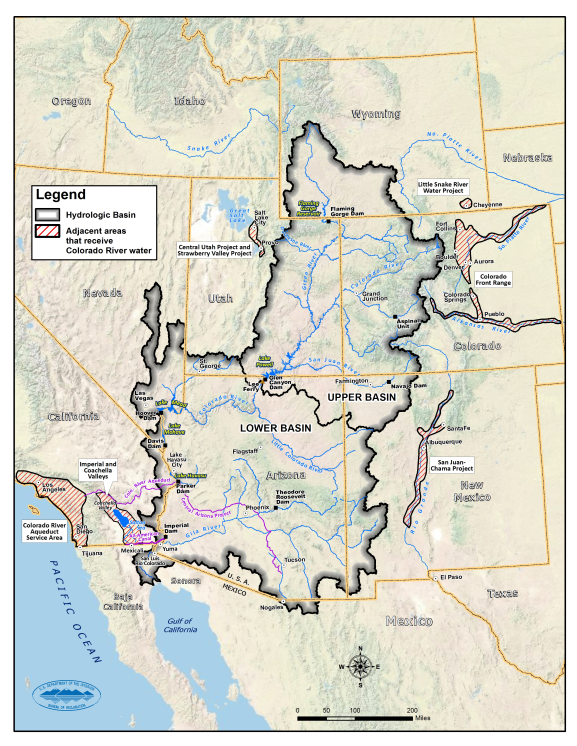
Source: Bureau of Reclamation.
The Colorado River Basin is a critical source of water and power supplies for seven western states and Mexico. The basin is in the midst of a long-term drought, and water levels at its two largest reservoirs, Lake Mead and Lake Powell, could reach critically low levels. Building on several prior agreements, the basin states and the Bureau of Reclamation (Reclamation) recently announced Drought Contingency Plans that aim to decrease the likelihood of major water and power supply curtailments for users.
The Colorado River Basin (Figure 1) covers approximately 246,000 square miles, 97% of which are in the United States. It includes the Colorado River and its tributaries, which cross the U.S. border into Mexico before discharging into the Gulf of California. Pursuant to federal law, multiple federal facilities (e.g., Hoover Dam and Glen Canyon Dam) store and convey water from the river and its tributaries and generate hydropower for the southwestern United States. The primary federal agency with jurisdiction over the river is Reclamation, an agency within the Department of the Interior (DOI).
 |
|
Source: Bureau of Reclamation. |
Based on observed data, average natural Colorado River flows in the 20th century were about 15 million acre-feet (maf) annually, while paleoclimate reconstructions estimated that mean annual flows were lower (ranging from 13-14.7 maf). Flows have dipped during the ongoing drought; Reclamation estimated that from 2000 to 2016, flows averaged 12.4 maf. These lower flows appear to parallel historic droughts on the river, some of which lasted for decades.
The Colorado River Compact of 1922, negotiated by the basin states and the federal government, is the foundation of the "Law of the River," which governs Colorado River operations. Under the compact, the states established a framework to apportion the water supplies equally between the Upper Basin and Lower Basin, with the dividing line at Lee's Ferry, AZ (near the Utah Border). Each basin was apportioned 7.5 maf annually. Congress approved the compact in the Boulder Canyon Project Act of 1928. Multiple other compacts, federal laws, court decisions, and regulatory guidelines have since added to the Law of the River. State-level apportionments were established by documents approved subsequent to the Colorado River Compact of 1922 (Figure 2). Pursuant to a 1944 treaty with Mexico, an additional 1.5 maf per year was reserved for flows south of the border.
When the Colorado River Compact of 1922 was approved, average annual flows on the river were assumed to be 16.4 maf per year. However, actual mean flows are considerably less than this amount and may decrease further. A 2012 Reclamation study projected a long-term imbalance in basin supply and demand. It noted the basin has thus far avoided serious impacts on supplies due to the significant storage within the system (60 maf), coupled with the fact that Upper Basin states have not fully used their entitlement. Additional supply constraints may result from tribal water rights. Tribes have diversion rights to 2.9 maf of Colorado River water, and several other reserved water rights claims for basin tribes have not been settled. These rights have the potential to take away from other apportionments.
After several years of negotiations, in October 2018 Reclamation and the basin states announced draft drought contingency plans (DCPs) for the Upper and Lower Basins. The DCPs aim to decrease the likelihood of major supply curtailments and other basin impacts. The plans build on a series of agreements dating to 2003 that have attempted to relieve pressure on basin water supplies and stabilize storage levels. Selected prior agreements most relevant to the DCPs include
The Upper Basin DCP would establish a Demand Management Program for the Upper Basin by authorizing storage of conserved water in Lake Powell. It also would establish 3,525 feet as the target operational level for Lake Powell. Together, these efforts would decrease the risk of Lake Powell's elevation falling below 3,490 feet, at which point reduced hydropower generation and cutbacks to water users are possible.
The Lower Basin DCP would require that when Lake Mead reaches predetermined elevations, Lower Basin states would forgo deliveries beyond previously agreed-upon levels. It also would incentivize voluntary conservation of water to be stored in Lake Mead and commit DOI to conserving 100,000 acre-feet of water that will be left in the system. The agreement's aim is to avoid Lake Mead elevations falling below 1,020 feet.
Implementation of the DCPs would require approval of multiple state agencies and contractors, as well as authorization by Congress. It is unclear what, if any, other federal commitments also might be required to implement the DCPs.